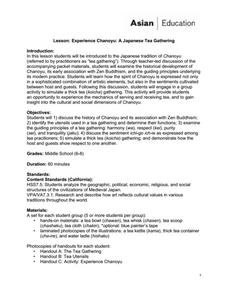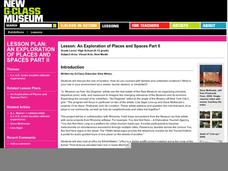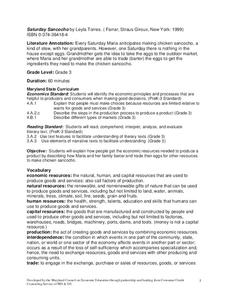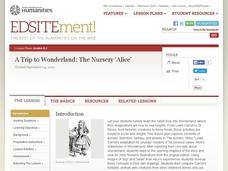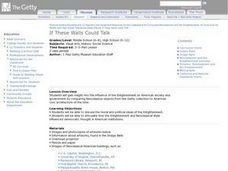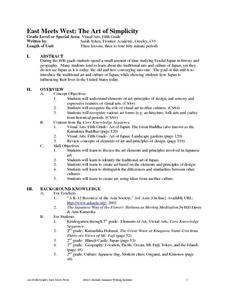National Gallery of Canada
Me or You in the 30's?
Take on portrait painting and tertiary colors with a plan focused on recreating a photograph. After viewing several pieces of artwork, class members follow the instructions included here to create portraits or self-portraits in a...
Curated OER
An Electronic Self-Portrait Lesson Plan - A Unit for Middle School
Using a photo of themselves for inspiration, learners create a multi-media self-portrait. A digital image of each child is taken, it is uploaded into the computer where is can be experimented with in a digital format. Young artists then...
Asian Art Museum
Experience Chanoyu: A Japanese Tea Gathering
As part of the study of Japanese cultural history, introduce your class members to Chanoyu, the Way of Tea. After a discussion of the history and key elements of Chanoyu, class groups perform the ceremony.
Curated OER
Robe Design
You can learn a lot from a robe, especially if that robe is from the Qing Dynasty. Examine the beauty and symbolism that covers a functional and piece of clothing entitled Winter Dragon Robe. The class will consider and analyze all...
Sargent Art
Symmetry: A Design Problem
As part of a study of design, young artists examine an example of a formal (symmetrical) design and then, following step-by-step directions, create their own.
Virginia Department of Education
Average Atomic Masses
Facilitate learning by using small objects to teach the principles of atomic mass in your science class. Pupils determine the average mass of varying beans as they perform a series of competitive experiments. They gather data and...
Sargent Art
Warhol-like Color Study
The lithographs of pop artist Andy Warhol inspire a instructional activity that asks young artists to try their hand at creating a study that demonstrates the effect color has on design. After drawing a self-portrait, participants paint...
New Class Museum
Lesson: An Exploration of Places and Spaces Part II
How does your location alter or impede your movement? An interesting question posed by two artists, who work to show the restrictions of people in various landscapes. Learners analyze both exhibitions, discuss location and movement, then...
Curated OER
Tony Cragg-Evidence
Students demonstrate an understanding of basic elements and principles of art making such as unity, variety, movement, and meaning found in daily experiences. They also describe the meaning of students¿ own artwork in a written statement.
Curated OER
Japanese Collage
Seventh graders compare and contrast different types of art associated with different cultures. They identify how cultures express their values in art. They create their own collage about Japan.
Curated OER
Saturday Sancocho
Second graders identify the economic principles and processes that are helpful to producers and consumers when making good decisions. Students will read, comprehend, interpret, analyze, and evaluate literary text as well as explain how...
Curated OER
A Trip to Wonderland: The Nursery "Alice"
Primary learners explore elements of wonder in The Nursery "Alice" by Lewis Carroll. They analyze the plot point after listening to the text. Next, they describe the imagery in various works of children's literature using the given links...
Curated OER
Making Inferences While Identifying Similes and Metaphors
Use this lesson to study similes and metaphors and the inferred meaning. In this language arts lesson, 5th graders write their own similes and metaphors. A worksheet is provided for extension work or to check understanding as homework.
Curated OER
Pattern Value Portraits with Light
Students use the elements of art and principles of design to explore value. In this color value lesson plan, students use the portrait of a a face to help them understand color value, tints, shades and tones.
Curated OER
Line and Pattern Design Paper Sculpture
The students create patterns and repeat colors for unity. They explore organic shapes and demonstrate awareness of design principles and art elements. They then create 3-D paper relief from a 2-D surface and demonstrate the difference...
Curated OER
If These Walls Could Talk
Young scholars investigate the influence of the Enlightenment on American society and government. In this Enlightenment lesson, students work cooperatively in groups to define the principles of the Enlightenment,...
Curated OER
Artsy Insects
Learners identify and describe the elements of art and principles of design by creating several different butterfly pictures that represent color, shape, texture, pattern or symmetry.
Curated OER
Beautiful Butterfly Tiles
Third graders create a butterfly drawing that includes the elements of art and principles of design. They create artwork that can be made into ceramic tiles to be installed around the classroom doorways in our new addition.
Curated OER
Exploring Photographs: Methods of Visual Analysis
Students use the methods of description, reflection, and formal analysis for a study of images. In this image analysis instructional activity, students work in teams to interpret and analyze an assigned work of art. Students write...
Curated OER
Coin Art 4-6
Students study the historical figures and symbols of U.S.
patriotism depicted on the penny, nickel, dime, and quarter coins and learn that artists designed the portraits and other images on the coins. They research Texas symbols and...
Curated OER
LETTER FROM ALEXANDER REID
Students examine Vincent Van Gogh's use of art elements and design principles, connect Van Gogh's style with his personality, and examine how the artist's perception of the sitter can influence the portrait.
Curated OER
Understanding Symmetry Through Visual Art
Have your class explore symmetry, radial balance and fractional parts in natural and man-made objects in their environment. Learners list examples and identify symmetrical and asymmetrical designs. Pupils are given a box of crayons and...
National Gallery of Canada
Self-Portrait, Mirrors and Metamorphosis!
Using M.C. Escher's Hand with Reflecting Sphere as inspiration, learners create their own set of self-portraits using various reflective surfaces. The lesson plan begins with a discussion about portraiture and ends with a presentation of...
Curated OER
East Meets West: The Art of Simplicity
Fifth graders examine the influences of Japan on American life through this three lesson unit. Feudal Japan with its traditional arts and culture is contrasted with current developments of the country.




